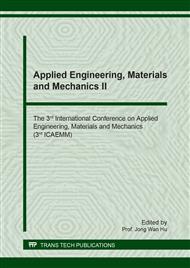[1]
W. J. Loesche, Role of Streptococcus mutans in human dental decay, Microbiol. Rev. 50 (1986) 353-380.
DOI: 10.1128/mr.50.4.353-380.1986
Google Scholar
[2]
B. M. Eley, Antibacterial agents in the control of supragingival plaque-a review, Br. Dent. J. 186 (1999) 286-296.
DOI: 10.1038/sj.bdj.4800090a
Google Scholar
[3]
L. M. McMurry, M. Oethinger, S. B. Levy, Triclosan target lipid synthesis, Nature. 394 (1998) 531-532.
DOI: 10.1038/28970
Google Scholar
[4]
F. Abdoul-Latif, P. Edou, F. Eba, N. Mohamed, A. Ali, S. Djama, et al., Antimicrobial and antioxidant activities of essential oil and methanolic extract of Jasminum sambac from Djibouti, Afr. J. Plant. Sci. 4 (2010) 38-43.
Google Scholar
[5]
A. S. Alrashdi, S. M. Salama, S. S. Alkiyumi, M. A. Abdulla, A. H. Hadi, S. T. Abdelwahab, et al., Mechanisms of gastroprotective effects of ethanolic leaf extract of Jasminum sambac against HCl/ethanol-induced gastric mucosal injury in rats, Evid. Based. Complement. Alternat. Med. 5 (2012).
DOI: 10.1155/2012/786426
Google Scholar
[6]
S. Sabharwal, M. Vats, S. Sardana, S. Aggarwal, Pharmacognostical, physico and phytochemical evaluation of the leaves of Jasminum sambac Linn. (Oleaceae), IJPPS. 1 (2011) 237-241.
Google Scholar
[7]
K. K. Chansukh, Antimicrobial activity of ethanolic extract from Jasminum sambac ait. Flowers, MFUIC & KTCM (2016) 38-43.
Google Scholar
[8]
C. Y. Loo, D. A. Corliss, N. Ganeshkumar, Streptococcus gordonii biofilm formation, identification of genes that code for biofilm phenotypes, J. Bacteriol. 182 (2000) 1374-1382.
DOI: 10.1128/jb.182.5.1374-1382.2000
Google Scholar
[9]
Y. Jin, H. K. Yip, Y. H. Samaranayake, J. Y. Yau, L. P. Samaranayake, Biofilm-forming ability of Candida albicans is unlikely to contribute to high levels of oral yeast carriage in cases of human immunodeficiency virus infection, J. Clin. Microbiol. 41 (2003).
DOI: 10.1128/jcm.41.7.2961-2967.2003
Google Scholar
[10]
V. Zijnge, M. B. van Leeuwen, J. E. Degener, F. Abbas, T. Thurnheer, R. Gmur, et al., Oral biofilm architecture on natural teeth, PLos. One. 5 (2010) e9321.
DOI: 10.1371/journal.pone.0009321
Google Scholar
[11]
W. Krzysciak, A. Jurezak, D. Koscielniak, B. Bystrowska, A. Skalniak, The virulence of Streptococcus mutans and the ability to form biofilms, Eur. J. Clin. Infect. Dis. 33 (2014) 499-515.
DOI: 10.1007/s10096-013-1993-7
Google Scholar
[12]
B. G. Riep, J. P. Bernimoulin, M. L. Barnett, Comparative antiplaque effectiveness of an essential oil and an amine fluoride/stannous fluoride mouthrinse, J. Clin. Periodontol. 26 (1999) 164-168.
DOI: 10.1034/j.1600-051x.1999.260306.x
Google Scholar
[13]
J. P. Ouhayoun, Penetrating the plaque biofilm, impact of essential oil mouthwash, J. Clin. Periodontol. 30 (2003) 10-12.
DOI: 10.1034/j.1600-051x.30.s5.4.x
Google Scholar
[14]
R. Seymour, Additional properties of essential oils, J. Clin. Periodontol. 30 (2003) 19-21.
Google Scholar
[15]
S. Burt, Essential oils, their antibacterial properties and potential applications in foods-a review, Int. J. Food. Microbiol. 94 (2004) 223-253.
DOI: 10.1016/j.ijfoodmicro.2004.03.022
Google Scholar
[16]
J. Kim, M. Marshall, C. Wei, Antimicrobial activity of some essential oils components against five foodborne pathogens, J. Agric. Food. Chem. 43 (1995) 2839-2845.
DOI: 10.1021/jf00059a013
Google Scholar
[17]
J. Juven, J. Kanner, F. Schved, H. Weisslowicz, Factors that interact with antimicrobial action of thyme essential oil and its active constituents, J. Appl. Bacteriol. 76 (1994) 626-631.
DOI: 10.1111/j.1365-2672.1994.tb01661.x
Google Scholar
[18]
C. Wendakoon, M. Sakaguchi, Inhibition of amino acid decarboxylase activity of Enterobacter aerogenes by active components in spices, J. Food. Prot. 58 (1995) 280-283.
DOI: 10.4315/0362-028x-58.3.280
Google Scholar
[19]
S. Thaweboon, B. Thaweboon, R. Kaypetch, Antimicrobial activity of jasmine oil against oral microorganisms, IOP. Conf. Series, Mater. Sci. Eng. 307 (2018) 012034.
DOI: 10.1088/1757-899x/307/1/012034
Google Scholar
[20]
P. Kunhachan, C. Banchonglikitkul, T. Kaisongkram, A. Khayungarnnawee, W. Leelamanit, Chemical composition, toxicity and vasodilatation effect of the flowers extract of Jasminum sambac (L.) Ait. G. Duke of Tuscany,, Evid. Based. Complement. Alternat. Med. 2012 (2012).
DOI: 10.1155/2012/471312
Google Scholar
[21]
B. Brul, P. Coot, Preservative agents in foods mode of action and microbial resistance mechanism, Int. J. Food. Microbiol. 50 (1999) 1-17.
DOI: 10.1016/s0168-1605(99)00072-0
Google Scholar
[22]
J. Sikkema, J. de Bont, B. Poolman, Mechanism of membrane toxicity of hydrocarbons, Microbiol. Rev. 59 (1995) 201-22.
DOI: 10.1128/mr.59.2.201-222.1995
Google Scholar


